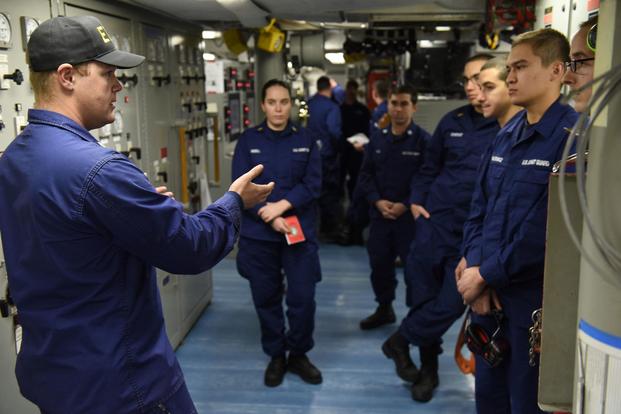Lt. Trump is pursuing a master's of science in civil engineering and a master's of business administration at the University of Washington.
This article originally appeared in the August 2019 issue of U.S. Naval Institute's Proceedings magazine.
Four decades ago, Lieutenant (junior grade) Beverly Kelley, U.S. Coast Guard, became the first woman to take command of a naval vessel. Yet today, women continue to leave the services at higher rates than men. In 2019, the Homeland Security Operational Analysis Center (HSOAC) identified barriers to female retention in the Coast Guard. Issues identified in the study include concerns regarding advancement, assignments, and sexual harassment and assault. One of the study's recommendations is to "explore creative solutions to female berthing limitations."
One creative solution would be to end the archaic policy of gender-segregated berthing aboard cutters. A shift to unisex berthing will further advance the Coast Guard's commitment to supporting female careers and reduce instances of sexual assault and harassment, likely improving female retention and mission effectiveness.
Break Down Barriers
The HSOAC found that while women "in the afloat sector had higher retention…sea time on cutters, other than [on large cutters] was particularly limited for women" because "female berthing restrictions limit[ed] their assignment options and opportunities for sea time." The lack of female berthing on cutters complicates an enlisted member's advancement, as sea time is required to advance in many rates. For example, a boatswain's mate (BM) must complete one year at sea to advance to chief petty officer (E-7), hold a cutter underway officer-of-the-deck (OOD) qualification to be assigned as an afloat-unit officer-in-charge or advance to senior chief petty officer (E-8), and complete one year of rated sea time as a first class petty officer (E-6) or above to compete for chief warrant officer (CWO). It is extremely difficult for any junior BM not billeted as an OOD on board a large cutter to attain an OOD qualification, as billeted OODs (chiefs, CWOs, and junior officers) take priority for bridge watchstanding and shiphandling opportunities. Therefore, simply sending junior female BMs to large cutters is not a solution. However, opportunities abound on board small cutters where junior BMs not only have the opportunity but are expected to qualify as OOD.
Also from Proceedings:
My cutter, USCGC Sea Dragon (WPB-87367) is an 87-foot patrol boat with a crew of 11, including two females, and racks for 12 separated into four double-occupancy rooms and one four-person stateroom. The three BMs are all billeted as OODs. Our newest OOD is a female BM1 who has never been permanently assigned to a cutter. She is only temporarily assigned to Sea Dragon, having convinced her shore command to allow her to pursue an underway OOD qualification with us. However, adding a third female put Sea Dragon at rack capacity because an odd number of each gender prevents using all 12 racks under a gender-segregated berthing policy. To accommodate the temporary duty female BM1, we must leave a permanent crewmember behind. After four months of steadfast dedication, she attained her OOD qualification. Unisex berthing would have negated the cumbersome logistics required to see her earn this significant career milestone.
Female BMs have been told by their afloat detailers that "the Coast Guard is not ready" for unisex berthing. One BM I know was forced to accept a shore assignment despite her desire to go to any ship, as there were no more afloat "female billets" available at her pay grade. This at a time when the Coast Guard acknowledges fewer servicemembers desire to go afloat. It is unlikely a junior female BM denied a rack afloat will ever again desire sea time as a senior BM. It is likely this closed-door will affect her decision to remain in the service.
Unisex berthing is already possible on many cutter classes. The two-person staterooms aboard Sea Dragon are tiny: two adults cannot comfortably stand inside simultaneously. Generally, the only time roommates are in their berthing area together is if one, or both, are asleep. In addition, the 87-foot cutters' heads and showers are single-occupancy by design and equipped with locks. Other cutter classes have single-occupancy heads as well. As Kelley said upon taking command, "When you use the head, you lock the door." Mature women and men can share berthing at no cost to the Coast Guard.
Degenderize the Service to Tackle Harassment and Assault
One may argue that unisex berthing increases the risk of sexual harassment and assault. Evidence suggests the opposite, however. In 2014, two Norwegian researchers conducted a study of northern Norway Army recruits for whom "unisex rooms were…commonplace." They found that "unisex rooms had a ‘degenderizing' effect." One recruit stated, "There is no gender in the army'…'there is only green." While the study did note challenges in other parts of the Norwegian military as it integrated women for the first time, researchers believe strong leadership made the difference for the recruits in the North. Strong Coast Guard leadership can establish a positive command culture where degenderization can reduce or eradicate sexual harassment and assault, as it will advance gender equality and desexualize our shipmates. When we consider someone a colleague or teammate before we consider them a man or a woman, we are less inclined to see them in a sexual context.
Unisex berthing will boldly lead service members to value each other as shipmates first, improve female retention, and bolster mission effectiveness and service readiness.
-- The opinions expressed in this op-ed are those of the author and do not necessarily reflect the views of Military.com. If you would like to submit your own commentary, please send your article to opinions@military.com for consideration.















